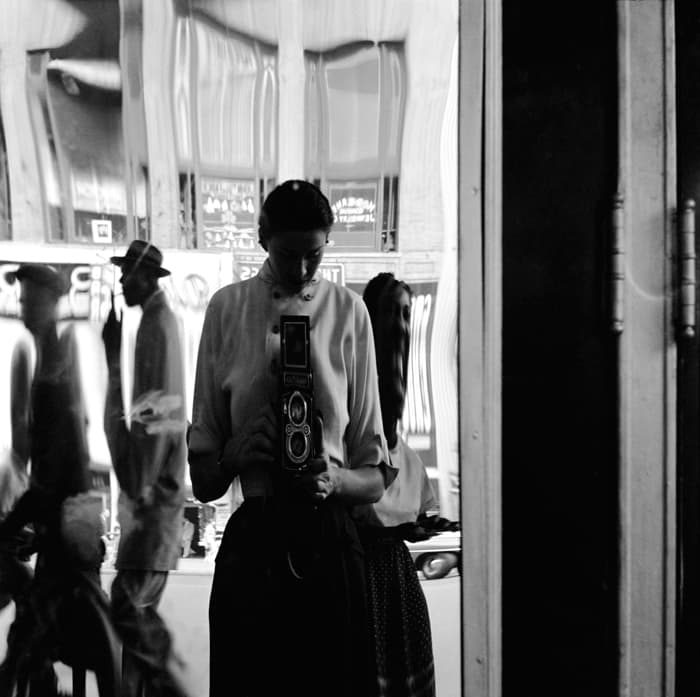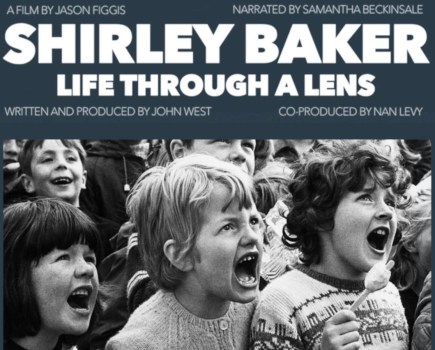Image: Self-portrait in a distorting mirror, 42nd street, New York, 1958 © Eve Arnold/Magnum Photos
Despite working in a heavily male-dominated profession, Eve Arnold became one of the most highly regarded photojournalists of the 20th century. She is best known for her candid portraits of Hollywood stars such as Marilyn Monroe, Joan Crawford and Marlene Dietrich, but she also produced reportage in countries such as China, India and Afghanistan.
The unique quality that runs throughout Arnold’s work is her close involvement with her subjects, whatever their social status. Whether she was photographing royal family members, film stars, political prisoners or prostitutes, she included them in the image-making process.
‘What I have tried to do is involve the people I was photographing, to have them realise, without saying so, that it was up to them to give me whatever they wanted to give me,’ Arnold said in a 2008 radio interview with John Tusa.
‘If you’re careful with people and if you respect their privacy, they will offer you part of themselves that you can use, and that is the big secret. It has more to do with the relationship of the photographer to the subject than it has to do with anything else that might be happening.’
Born in Pennsylvania in the USA in 1912, Arnold’s interest in photography first began by chance when a boyfriend gave her a camera as a present in her early medical training. She remained an amateur photographer for several years and in the mid-1940s, after getting married, she worked in a Brooklyn photo-finishing plant for five years.
The turning point in her life came when she took a six-week photography course at the New York School for Social Research and was taught by Alexey Brodovitch, then the art editor at Harper’s Bazaar. As a course assignment she shot documentary images on fashion in Harlem and these photographs were subsequently published in the UK by Picture Post.
She followed this story with a photo essay on migrant labourers in Long Island, and in 1951 she approached the recently formed Magnum Photos with these two portfolios. The organisation’s co-founder, Robert Capa, agreed to take her on as its first female associate member.
Her longstanding Magnum colleague Elliott Erwitt, who first met her during this period, felt that Arnold’s physical stature (she was 4ft 10in/1.2m tall) was a useful asset on assignments. ‘She was a tiny, unaggressive kind of person who you wanted to pick up and be nice to, although that was the surface,’ he later commented. ‘She had steel and integrity and a work ethic.’
Arnold took on a variety of assignments in these early years, including photographing Marlene Dietrich for Esquire. She shot her in a recording studio, using a documentary style very different from the carefully lit and heavily retouched film-star shots generally published in magazines at that time.
Image: Marilyn Monroe during the filming of John Huston’s The Misfits. Reno, Nevada, 1960 © Eve Arnold/Magnum Photos
While at a Hollywood party in 1952, Arnold was approached by Marilyn Monroe, who had seen the Dietrich pictures. Monroe said, ‘If you can do that well with Marlene, can you imagine what you could do with me?’ Arnold photographed her for Esquire and again on five more assignments during the next ten years. Her informal photographs captured Monroe’s beauty, glamour and sense of fun, but also her darker moods and underlying vulnerability.
Arnold later commented, ‘When we met, we were two young women starting out. She was a starlet, no place yet in the Hollywood hierarchy. I was beginning as a photographer. Neither one of us knew anything about our craft and that was a bond between us, so I don’t know where she ended and I began, or I ended and she began.’
Arnold started working for Life and was associated with the magazine for a number of years, covering subjects such as poor communities in South Africa and political prisoners in Russia. Her USA reportage included the rise of the civil rights movement and changing race relations.
In 1962, Arnold relocated to England while her son, Frank, was educated at Bedales boarding school. She soon began working as a contract photographer for The Sunday Times magazine and continued this work for ten years. Apart from six years she spent working abroad, Arnold has lived in the UK ever since.
One of her longstanding ambitions was to visit China, and she was finally allowed a visa to work in the country in 1979. She was 67 years old, but approached the assignment with great energy and enthusiasm, working on it for more than five months.
She covered more than 40,000 miles in locations from Beijing to Mongolia, documenting the people’s way of life, their customs and their environment. These images offered an insight into daily life in China that was rarely seen, and formed her first major solo exhibition in 1980.
Arnold received many prestigious awards for her work, including an OBE in 2003. She finally gave up photography in her mid-80s and concentrated more on writing. Now 98, Arnold lives quietly in a London nursing home at the end of an unusually long and active life.

Image: Black and white children at a party to introduce mixed schools, Virginia, 1958 © Eve Arnold/Magnum Photos
Her feelings about spending her life as a photographer were summed up in a quote from a 1982 interview with fellow photographer Pat Booth. ‘I have never regretted my decision to become a photographer because it’s the most demanding thing I have ever done,’ she said. ‘There are so many dimensions to it. I feel that in photography I’m using my creative ability to the absolute maximum.’
Biography
- 1912: Born on 21 April in Philadelphia, Pennsylvania, one of nine children, to Russian-Jewish immigrant parents
- 1940s: Works in a photo-finishing plant in New York City, where she quickly rises to the post of manager
- 1948: Studies photography under Alexey Brodovitch at the New School for Social Research in New York
- 1951: Robert Capa invites her to become the first woman associate member of Magnum Photos
- 1952: Photographs Marilyn Monroe for Esquire magazine and they become friends
- 1957: Becomes a full member of Magnum Photos
- 1962: Moves to London while her son, Frank, is educated at Bedales boarding school and she remains a UK resident
- 1979: Makes the first of two trips to China to shoot an extensive documentary project on the country
- 1980: In China, her first major solo exhibition, is held at the Brooklyn Museum, New York
- 1995: Elected a Master Photographer by the International Centre of Photography in New York and made a Fellow of the RPS
- 2003: Awarded an OBE for her services to photographyBooks and Websites
Books and websites
Books: Arnold has published more than a dozen books. Of those currently in print, Eve Arnold’s People (Thames & Hudson, 2009) offers a collection of her best portraiture, while Eve Arnold: Film Journal (Bloomsbury, 2002) focuses on her work on movie sets. Many of her other books are available second-hand on www.amazon.co.uk.
Websites: More of Arnold’s images can be viewed on www.magnumphotos.com. John Tusa’s 2008 Radio 3 interview with Arnold can be found by going to www.bbc.co.uk/radio3 and searching for ‘Eve Arnold interview’.







